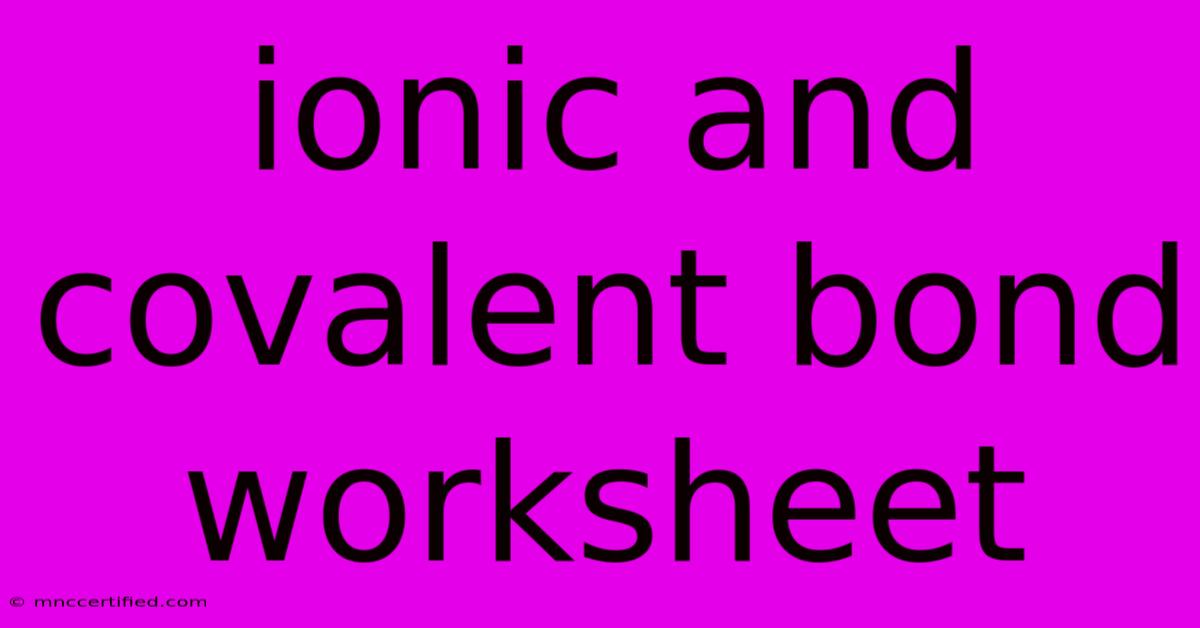Ionic And Covalent Bond Worksheet

Table of Contents
Ionic and Covalent Bond Worksheet: A Comprehensive Guide
This article provides a comprehensive guide to understanding ionic and covalent bonds, complete with a sample worksheet and answers. It's designed to help students solidify their understanding of chemical bonding and prepare for assessments. We'll cover key concepts, examples, and strategies for mastering this important chemistry topic.
Understanding Ionic Bonds
Ionic bonds form through the electrostatic attraction between oppositely charged ions. This occurs when one atom donates an electron (or more) to another atom, resulting in a positively charged cation and a negatively charged anion. The strong attraction between these ions creates a stable ionic compound.
Key Characteristics of Ionic Bonds:
- High melting and boiling points: The strong electrostatic forces require significant energy to overcome.
- Crystalline structure: Ions arrange themselves in a regular, repeating pattern in a solid state.
- Conduct electricity when dissolved or molten: The freely moving ions can carry an electric current.
- Brittle: A shift in the crystal lattice can cause like charges to repel, leading to fracture.
Examples of Ionic Compounds:
- Sodium chloride (NaCl): Sodium (Na) loses one electron to become Na⁺, and chlorine (Cl) gains one electron to become Cl⁻.
- Magnesium oxide (MgO): Magnesium (Mg) loses two electrons to become Mg²⁺, and oxygen (O) gains two electrons to become O²⁻.
- Potassium iodide (KI): Potassium (K) loses one electron to become K⁺, and iodine (I) gains one electron to become I⁻.
Understanding Covalent Bonds
Covalent bonds form when atoms share one or more pairs of electrons. This sharing creates a stable molecule where each atom achieves a full outer electron shell (octet rule).
Key Characteristics of Covalent Bonds:
- Lower melting and boiling points compared to ionic compounds (generally, but exceptions exist).
- Can be gases, liquids, or solids at room temperature.
- Poor conductors of electricity: Electrons are involved in bonding and not free to move.
- Often form molecules with specific shapes.
Examples of Covalent Compounds:
- Water (H₂O): Oxygen shares electrons with two hydrogen atoms.
- Methane (CH₄): Carbon shares electrons with four hydrogen atoms.
- Carbon dioxide (CO₂): Carbon shares electrons with two oxygen atoms.
Ionic vs. Covalent Bonds: A Comparison
| Feature | Ionic Bond | Covalent Bond |
|---|---|---|
| Bond Formation | Electron transfer | Electron sharing |
| Electronegativity Difference | Large | Small |
| Melting/Boiling Point | High | Generally lower |
| Conductivity | Conducts when molten or dissolved | Poor conductor |
| Structure | Crystalline lattice | Molecules |
| Examples | NaCl, MgO, KI | H₂O, CH₄, CO₂ |
Ionic and Covalent Bond Worksheet: Practice Problems
(Note: This is a sample worksheet. Adjust the difficulty and number of questions based on the student's level.)
Identify each compound as primarily ionic or covalent:
- H₂O
- NaCl
- CO₂
- MgCl₂
- CH₄
- KBr
- NH₃
- CaO
- HCl
- SO₂
Draw Lewis dot structures for the following molecules:
- H₂O
- CH₄
- CO₂
Answers to Worksheet
(Remember to check your work against a periodic table and your understanding of valence electrons.)
Identifying Ionic/Covalent Compounds:
- Covalent
- Ionic
- Covalent
- Ionic
- Covalent
- Ionic
- Covalent
- Ionic
- Covalent (although it ionizes in water)
- Covalent
Lewis Dot Structures: (These require visual diagrams which cannot be effectively represented in markdown. Consult a chemistry textbook or online resource for examples.)
Beyond the Worksheet: Further Learning
This worksheet provides a foundational understanding of ionic and covalent bonds. For deeper learning, explore resources like Khan Academy, Chemistry LibreTexts, and your chemistry textbook. Understanding the concepts of electronegativity and polarity will enhance your ability to predict bond types. Remember to practice drawing Lewis structures and identifying bond types in various compounds to build your proficiency.
By consistently practicing and reviewing these concepts, you’ll master the complexities of ionic and covalent bonds. Good luck!

Thank you for visiting our website wich cover about Ionic And Covalent Bond Worksheet. We hope the information provided has been useful to you. Feel free to contact us if you have any questions or need further assistance. See you next time and dont miss to bookmark.
Featured Posts
-
Texas Vs Arkansas Where To Watch Live
Nov 17, 2024
-
Liquor Liability Insurance Georgia
Nov 17, 2024
-
Met Office Issues Stoke Snow Ice Alert
Nov 17, 2024
-
Nations League Ronaldos Double Portugal Wins
Nov 17, 2024
-
Car Insurance Quotes In Forsyth Mt
Nov 17, 2024